Posted in Projects on Dec 29th, 2011
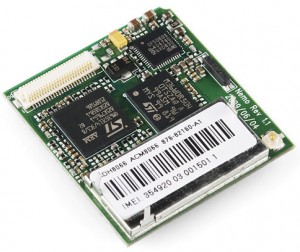
I’ve been looking at GSM modems and wondering how I could integrate them into my projects, they are around $50 or so (Sparkfun) to play around with. I’m thinking of using them to send an SMS when an alert is detected for a sensor, this could be a smoke detector, intruder alarm, temperature rise, etc. All you would need is a pre-paid SIM card and some credit to last a few months.

With everything, I want to use something that I already have and in this case I have some old mobile phones. It’s crazy to think that you can buy new cheap mobile phone now for around $26.

One of the old phones I have is a Nokia 3120. I’ve read there is a MBUS/FBUS protocol which you can use to send or receive SMS’s however my attempts to send any data to the phone fell on deaf ears, I could probably figure out what I should be sending if I had a data cable to sniff the traffic. So I was left with the only thing I could do, wire up the keys and make our MCU press them for us.
(more…)
Read Full Post »
Posted in Projects, Tinkering on Dec 18th, 2011
I recently received a question in regards to the thermistor formula found on one of the SATL build posts asking how I came about the variables used in the thermistor formula. The thermistor formula and variables I used can be found on the Arduino Playground however it made me think if the formula being used was accurate for the Vishay 10K thermistor I was using.
Below we have the Thermistor function in question in which it converts the ADC value to a resistance value in ohms, applies a formula and convert the result to celsius.
double Thermistor(int RawADC) {
double Temp;
Temp = log(((10240000/RawADC) - 10000)); // Minus by 10K as that's the resistor in series with the thermistor
Temp = 1 / (0.001129148 + (0.000234125 * Temp) + (0.0000000876741 * Temp * Temp * Temp));
Temp = Temp - 273.15; // Convert Kelvin to Celcius
return Temp;
}
Steinhart–Hart equation
The formula used is called the Steinhart–Hart equation which models resistance to temperature, there is the “full version” and the “commonly used” one. A, B, C and D in the functions below are called the coefficients.
Full version: 1/T= A + B*ln(R/Rt) + C*ln(R/Rt)2 + D*ln(R/Rt)3
Commonly used: 1/T= A + B*ln(R/Rt) + D*ln(R/Rt)3
(more…)
Read Full Post »
Posted in Projects on Dec 5th, 2011
I have some rechargeable batteries which are on their way out as they only seem to last 1-3 weeks but I never quite know when they are flat when they aren’t being used. So Instead of buying new rechargeable batteries (which is the easy solution), I thought why not make a simple project out of it.
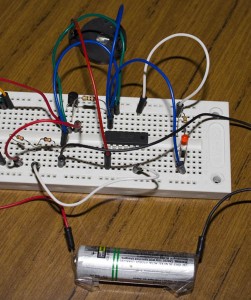
(Testing with only 1 AA battery)
Introducing the Low Voltage Battery Monitor (LVBM) – a 4x AA battery monitor which will blink an LED every 4 seconds if a battery is found flat and checks good batteries every 15 minutes.
AA Battery drop off voltage / ADC
Firstly we need to find the voltage when an AA battery drops off, we can find this on an AA battery datasheet: http://data.energizer.com/PDFs/nh15-2300.pdf.
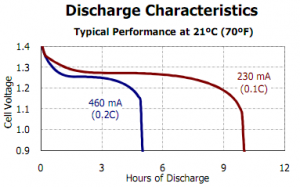
(more…)
Read Full Post »
Posted in Projects on Nov 5th, 2011
Today we’ll be making a modification to the Standalone Temperature Logger which will allow us to log voltage instead of temperature. I would like to log the voltage of a 12 volt battery or the small solar panel that’s charging it, so I’m aiming for a voltage range of 0 to 15 volts.
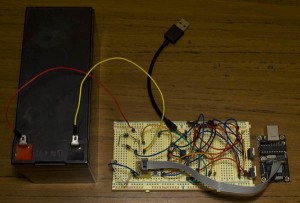
The ATtiny85 in the SATL is powered by a 3 volt battery and the ADC (analog to digital converter) measures 0 – Vcc by default (3V in this case). How can we use the ADC (analog to digital converter) to increase its range to 15V? We can use a voltage divider to divide the voltage by a certain ratio.
Read Full Post »
Posted in Projects on Oct 31st, 2011
So I was making a modification to the Standalone Temperature Logger (SATL) to make it log voltage instead of temperature and happen to discover an issue with the Brown-out Detector which is set to 2.7V. Download the SATL v2.1 or visit the SATL project page.
It turns out that I had a 3V coin cell which was a bit discharged as it was sitting at 2.95 volts and when I connected it to the circuit it would drop to 2.7 volts and draw about 0.5mA of current which was very odd. At 2.95 volts I thought it should still have some life left. After trying to program very simple programs to the ATtiny85 like a blinking LED, making it sleep right away, etc I had no success. Eventually I reset the fuse bits and it all started working well again which lead me to discovering that BOD was the issue.
I tried adding 0.1uF, 4.7uF and 470uF capacitors which sometimes worked but it wasn’t reliable. I’m now recommending that BOD be disabled for the SATL unless you know the 3V coin cell is brand new or near new condition. The BOD issue brought my attention to other places within the SATL that could be improved upon.
Increase the button pull down resistor
Connected to the button we have a standard 10k pull down resistor and each time the button is pressed or held 0.3mA is consumed, seems sort of wasteful.
(more…)
Read Full Post »
Posted in Projects on Jul 10th, 2011
The Standalone Temperature Logger has now been updated to v2.0 with the PCB, schematic, guide and source all available for download.
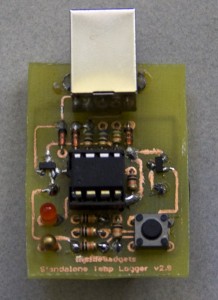
I kind of took a little break and came back to figure out the PCB, once it was done all that was left was to try it out and create the new documentation for it. Since I’m using 2 SMD Mosfets I thought that soldering them would be really difficult but it turned out to be easier than I expected. Testing went well and am quite happy with how it turned out.
So go ahead and check out the updated project page for the Standalone Temperature Logger v2.0.
Read Full Post »
Posted in Projects on Jun 18th, 2011
Last week we built an automatic voltage switching circuit and now it’s time to apply this circuit to the Standalone Temperature Logger (SATL).
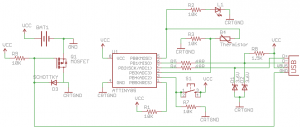
Let’s bring up the new schematic for the SATL with the voltage switching circuit. As you can see like last week, we separate the grounds of the voltage sources – the 3V battery and USB. Notice that CRTGND is not the same as GND, CRTGND connects to the mostfet drain/schottky diode.
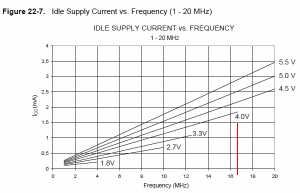
There is a downside to this circuit which is that there is a voltage drop when running from the USB side due to the diode. The USB voltage can vary between 4.75V to 5.25V and the good news is that our ATtiny85 can run fine at 16.5MHz whilst at 4.0V.
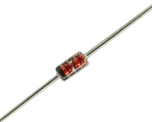
If the USB voltage was really 4.75V, we would just make it to 4.05V but we want the best possible voltage even if it was 4.75V. Instead of using just a standard diode we’ll use a schottky diode which can provide a lower voltage drop of 0.3V instead of the 0.7V from standard diodes.
(more…)
Read Full Post »
Posted in Projects on May 29th, 2011
Today I’ll be showing how we can integrate the Standalone Temperature Logger (SATL) into the V-USB Test program we have. It’s taken me a little while to find my way around V-USB and its kinks.
Schematic
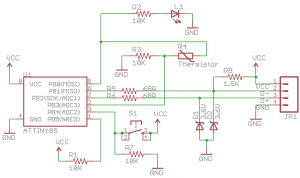
The schematic has been updated to include the USB port. Another change is that when the LED turns on it also turns on the thermistor, before we used to do this with the dataPin.
Cleaning up the V-USB code
The first thing I’ve done is copy over our setup.c file from the SATL WinAVR to our project and then move everything related to V-USB setup or procedures (except the sending of keys) to our setup.c file which now leaves us with just two functions in main.c (evaluateADC and main).
Next I would like to cut down on the main’s USB setup code, lets make a new function called startUSB() and place all the code below in it.
(more…)
Read Full Post »
Posted in Projects on May 14th, 2011
Today we’ll be modifying the ATtiny85_Blink WinAVR example to convert the Standalone Temperature Logger from using the Arduino software to WinAVR so that we can easily integrate it in with V-USB. Download here: Standalone_Temperature_Logger_v2.0_Beta_1
Changes to setup.c
Let’s begin with the setup.c file, to make things easier we will put all of our commonly used functions in this file too.
// Used from http://www.arduino.cc/playground/ComponentLib/Thermistor2
double Thermistor(int RawADC) {
double Temp;
Temp = log(((10240000/RawADC) - 10000));
Temp = 1 / (0.001129148 + (0.000234125 * Temp) + (0.0000000876741 * Temp * Temp * Temp));
Temp = Temp - 273.15; // Convert Kelvin to Celcius
return Temp;
}
First we put in the Thermistor function without any changes made.
// Used from http://interface.khm.de/index.php/lab/experiments/sleep_watchdog_battery/
void system_sleep(void) {
DDRB &= ~((1<<ledPin) | (1<<dataPin)); // Set outputs to inputs to save some power
cbi(ADCSRA,ADEN); // Switch Analog to Digital converter OFF
set_sleep_mode(SLEEP_MODE_PWR_DOWN); // Set sleep mode
sleep_mode(); // System sleeps here
sbi(ADCSRA,ADEN); // Switch Analog to Digital converter ON
DDRB |= ((1<<ledPin) | (1<<dataPin)); // Set those outputs back to outputs
}
Next we insert the system_sleep function, other than the switching between outputs and inputs which is done using DDRB. Notice that we have referenced ledPin and dataPin, we will define those ports in the main.c file.
(more…)
Read Full Post »
Posted in Projects on May 2nd, 2011
So I’ve finally gotten myself a USBtinyISP Programmer to use instead of the Arduino acting as an ISP. It comes with a 10 and 6 pin cable. For my needs I’ll just be using it on a breadboard and using wires from the 6 pin cable was a little tedious.
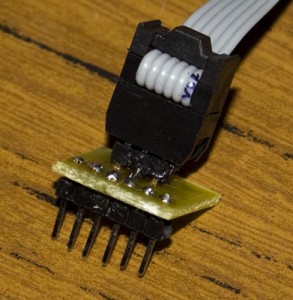
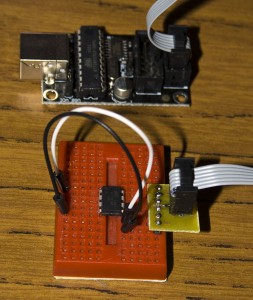
I decided just to make a simple PCB to convert those 6 pins (2×3 pins) into a 6 pin header specifically made for the ATtiny25/45/85 as it you can just simply plug it on the right hand side of the ATtiny and then just wire up the Reset and Ground lines.
More information and download available at the ISP to BB Connector project page.
Read Full Post »
















